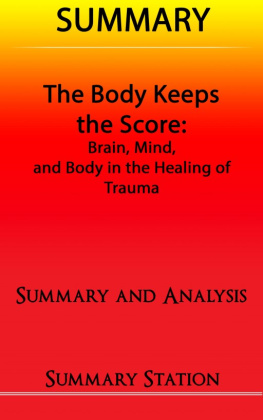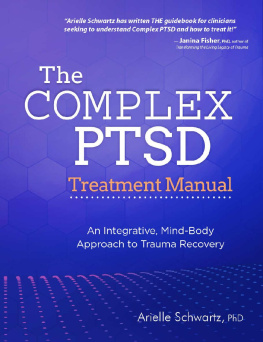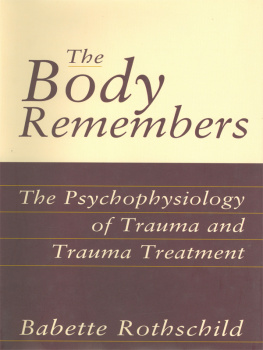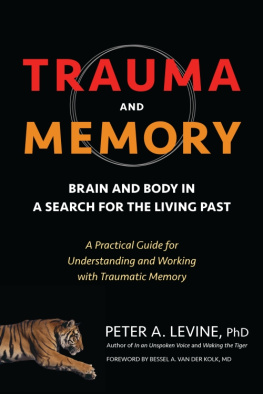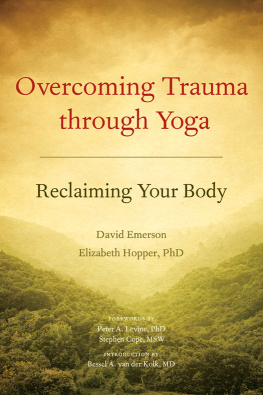A NORTON PROFESSIONAL BOOK
The Body
Remembers
The Psychophysiology
of Trauma and
Trauma Treatmen
BABETTE ROTHSCHILD

For Margie
Contents
I t is not possible to tackle the arduous project of writing a professional book without being taught, helped, influenced, inspired, and advised by others. Those who have crossed my path in the 28 years since my entry into the psychotherapy field are too numerous to mention individually, though all have contributed in some way. Collectively, I would like to thank each of the teachers, therapists, supervisors, and researchers who have helped me to shape my opinions into a serviceable form. Those who have most influenced my thinking with regard to trauma theory and treatment are acknowledged by reference within the pages of this text. Nonetheless, I would like to particularly recognize Lisbeth Marcher and her colleagues at Denmarks Bodynamic Institute, Peter Levine, and Bessel van der Kolk. They have had a profound influence on the evolution of the ideas expressed in these pages. I would also like to express my grateful thanks to the many trainees, supervisees, students and clients who have all, in ways both small and large, contributed to the content of this book. Like many, I have learnedand continue to learnthe most from those I have had the privilege to teach and treat.
I would like to express gratitude specifically to Karen Berman, Danny Brom, Alison Freeman, Michael Gavin, David Grill, John May, Yvonne Parkins, Gina Ross, and Sima Juliar Stanley for their brutally critical comments on this manuscript. In addition, I want to thank life sciences writer, Karin Rhines, for being such a great coach throughout this project. Her knowledge of the business of writing, as well as her uncanny ability to know just when to cheer and when to chide, has been invaluable.
I consider myself to be a very fortunate author to have Norton Professional Books as my publisher. Having previously read many grateful acknowledgments to my editor, Susan Munro, I now know what everybody was talking about. In addition to being a skilled, patient, and good-humored editor, her knowledge of my subject matter as well as her command of the professional literature has been an invaluable bonus. In fact, I have been heartened by my contacts with all of the staff I have encountered at W.W. Nortonon both sides of the Atlantic. They have each and all contributed to making the writing of this book a pleasure.
T he Body Remembers is intended as a complement to existing books on the theory and treatment of trauma and posttraumatic stress disorder and to the existing methods of trauma therapy. It is hoped that it will add the dimension of understanding and treating the traumatized body to the already well-established knowledge of and interventions for treating the traumatized mind . Psychotherapists working with traumatized clients will in all likelihood find that the theory, principles, and techniques presented within these pages are consistent with and applicable to the therapy model(s) in which they are already trained. In addition, they should find that the information presented here can be used and adapted without conflict with, or abandonment of, their preferred principles or techniques.
The Body Remembers is meant to be a bridge-building book. It is my hope to traverse at least two of the deep chasms within the field of traumatology. The first bridge spans the gap between the theory developed by scientists, particularly in the area of neurobiology, and the clinical practice of therapists working directly with traumatized individuals and groups. The second bridge aims to connect the traditional verbal psychotherapies and those of body-oriented psychotherapy (body-psychotherapy).
The gaps between mind and body, traditional psychotherapy and body-psychotherapy, and between theory and practice have long been of concern to me. Increasingly I have found that posttraumatic stress disorder (PTSD) is forcing a bridging of these gaps. Even the most conservative of therapists and researchers acknowledges that PTSD is not just a psychological condition, but also a disorder with important somatic components. Moreover, all professionals who deal with PTSD find that they must stretch their theories and practice. Both psychotherapists and body-psychotherapists are pressed to pay greater attention to neurobiologic theory and to account for and treat somatic symptoms, the body-psychotherapist must also find ways to work without touch and to increase verbal integration, and the researcher is being challenged to make more pertinent connections between theory and practice. It is my hope that The Body Remembers will facilitate meaningful links in bridging these gaps.
Science vs. Practice
A Widening Gulf Splits Lab and Couch read the headline of the New York Times Womens Health section on June 21, 1998 (Tavris, 1998). Most psychotherapists knew it, but many of my colleagues were surprised to see such criticism in print. Not a few were offended. The author of that article, Carol Tavris, claimed that psychological science is an oxymoron. She criticized practitioners for paying too little attention to science, often being more focused on technique than theory. Most of the professionals I have spoken with agree with Carol Tavris that scientific theory and practice are usually too divergent to be relevant when they are sitting with a client. I, however, believe that this gap between scientist and practitioner is one of semantics rather than principles. The language of the scientific literature is often difficult to read and comprehend, though much that is being offered is extremely relevant, if difficult to translate into the language of practice.
I have endeavored in The Body Remembers to present theory in an easily accessible form that is relevant to direct practice. By so doing, I hope to narrow the chasm between the neuroscientist and behavioral researcher studying the phenomenon of trauma and the psychotherapist working directly with the traumatized client.
Theory is the most valuable tool of the trauma therapist, because understanding the mechanisms of trauma as proposed by psychological, neurobiological, and psychobiological theory greatly aids treatment. The greater a therapists theory base, the less dependence there will be on techniques learned by rote. Thorough understanding of the neurological and physiological underpinnings of the trauma response and the development of PTSD will enable on-the-spot creation and/or adaptation of interventions that are appropriate and helpful to a particular client, with his particular trauma. A theoretical foundation also aids therapists in applying techniques learned from various disciplines, choosing and enhancing those that have the best chance of success in each unique situation. The therapist well versed in theory is able to adapt the therapy to the client, rather than assuming the client will fit into the therapy.
Psychotherapy vs. Body-psychotherapy
It is my additional hope that this book will build a bridge between the practitioners of traditional verbal psychotherapies and the practitioners of body-oriented psychotherapies. I believe that these two professional groups have much to offer each other in the treatment of trauma and PTSD.
The first encouragement I came upon for traversing this chasm was Bessel van der Kolks seminal article, The Body Keeps the Score, in the Harvard Review of Psychiatry (van der Kolk, 1994). It was in this article that I first found the body-mind connection legitimized in mainstream psychiatry. In addition, Antonio Damasios Descartes Error (1994) has been a great inspiration. This groundbreaking book presents a neurological, theoretical basis for the mind-body connection. Both of these works have laid the foundation for my understanding of the psychophysical, neurobiological relationship between the mind and the body. Further, the recent work of Perry, Pollard, Blakley, Baker, and Vigilante (1995), Schore (1994, 1996), Siegel (1996, 1999), van der Kolk (1998), and others on infant attachment, brain development, and memory systems has tremendous implications for our understanding of how trauma could so adversely disrupt the nervous system that an individual would develop PTSD.
Next page

